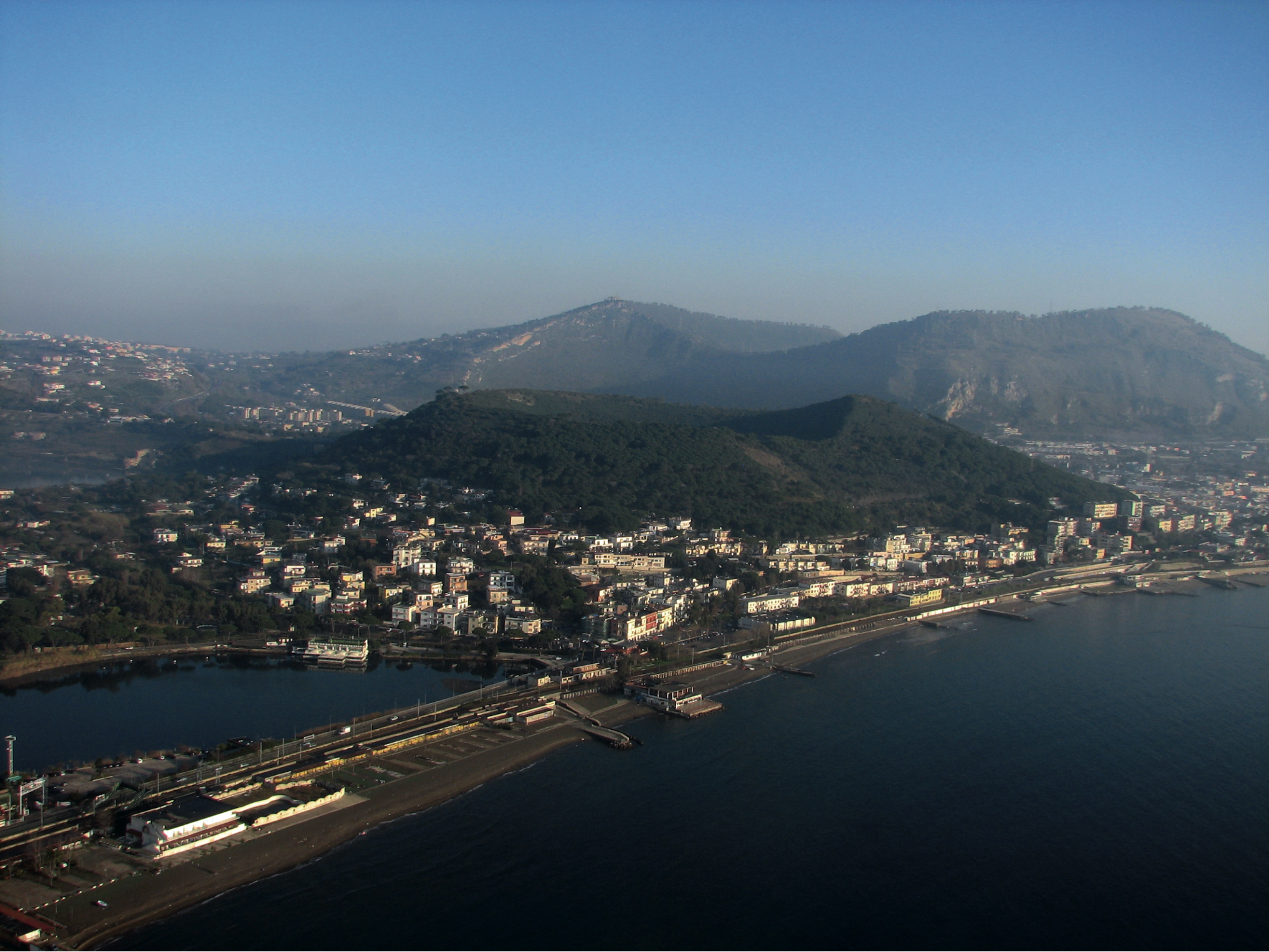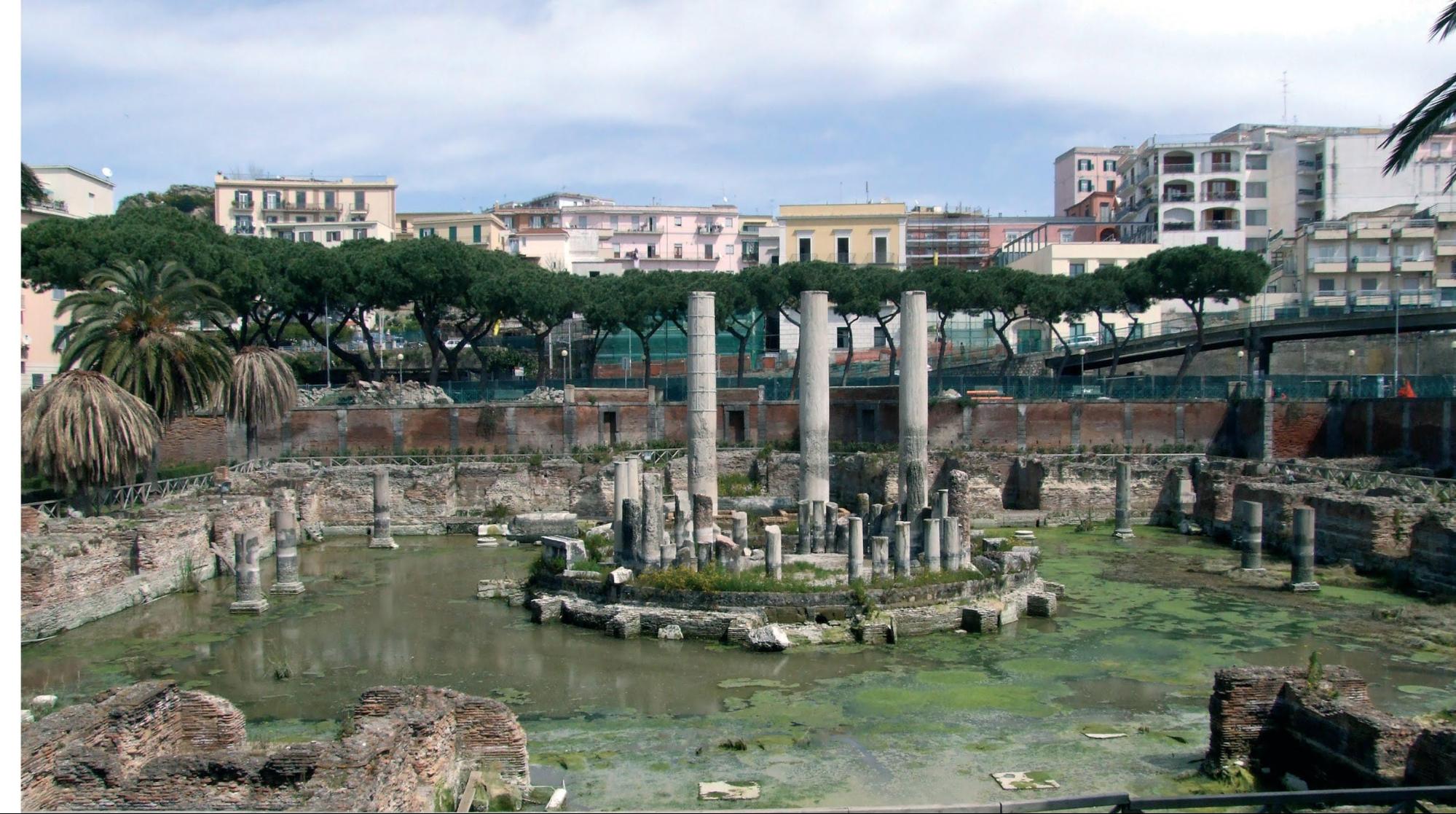The so-called Temple of Serapis in Pozzuoli, on whose columns the marks left by marine organisms (lithodomas) are visible during the phases of subsidence of this sector of the Campi Flegrei caldera and therefore submersion under the lm, which occurred due to bradyseism.
 In the foreground, Monte Nuovo, the last of the volcanic cones formed inside the Campi Flegrei Caldera (September 1538 AD). On the left below, Lake Lucrino, near which the village of Tripergole once stood and was completely destroyed by the eruption of M. Nuovo, together with all its civil, religious and military buildings and the ancient thermal springs; Lake Lucrino itself was significantly reduced by the products of the eruption. On the right side of the volcanic cone you can see the town of Arco Felice-Pozzuoli. In the background of the photo, the edge of the crater of Mount Gauro, whose peak to the north is called Mount Sant'Angelo and to the south, Mount Barbaro.
In the foreground, Monte Nuovo, the last of the volcanic cones formed inside the Campi Flegrei Caldera (September 1538 AD). On the left below, Lake Lucrino, near which the village of Tripergole once stood and was completely destroyed by the eruption of M. Nuovo, together with all its civil, religious and military buildings and the ancient thermal springs; Lake Lucrino itself was significantly reduced by the products of the eruption. On the right side of the volcanic cone you can see the town of Arco Felice-Pozzuoli. In the background of the photo, the edge of the crater of Mount Gauro, whose peak to the north is called Mount Sant'Angelo and to the south, Mount Barbaro.
Location and maximum height: 40° 50' 00"N, 14° 10' 00" E; Camaldoli= 458 m asl
Total area: 130 km2 (rough estimate of the caldera area, including the sea part)
Volcano type: Caldera and monogenic cones
Main types of eruptions: phreatomagmatic, strombolian, plinian
Prevailing phenomena: hydrothermal emissions, ground deformations, seismicity
Beginning of eruptive activity: > 60.000 years
Last eruption: 1538
Activity state: quiescent
Alert level: attention
The Campi Flegrei are a volcanic system whose activity began more than 80.000 years ago.
Their eruptive history is dominated by the eruptions of Campanian Ignimbrite (40.000 years ago) and Neapolitan Yellow Tuff (15.000 years ago), which led to the formation of a complex caldera, on whose origin and history the scientific debate is still heated.
During the Campanian Ignimbrite eruption, the most violent in the Mediterranean area, pyroclastic currents were generated which buried two thirds of Campania under a thick blanket of tuff. Following this eruption, the Campi Flegrei and a part of the area now occupied by the city of Naples sank, generating a caldera that was invaded by the sea.
In the millennia that followed, volcanic activity concentrated in the area inside the caldera, forming eruptive centers and new land.
The eruption of Neapolitan yellow tuff devastated an area of approximately 1.000 km2 and caused the sinking of a smaller caldera contained within the first. In the last 10.000 years, the central part of this caldera has been affected by an uplift of about 90 m, as a result of a resurgence phenomenon which has profoundly conditioned subsequent volcanic activity.
The post-Tuff Giallo Napoletano activity continued inside the caldera with more than 70 eruptions, mainly explosive, concentrated in three Epochs of intense activity, separated by long periods of quiescence: Epoch I, between 15.000 and 9.500 years ago; Epoch II, between 8.600 and 8.200 years ago; Epoch III, between about 5.500 and 3.800 years ago, and generated the tuff cone of Monte Nuovo. The eruption was preceded by important precursor phenomena (seismicity, uplift of the ground in the area of the crater in formation, degassing), lasted a week and was dominated by phreatomagmatic explosions, with generation of pyroclastic currents and fall deposits.
Today the Phlegrean area is home to intense fumarolic activity (La Solfatara, Pisciarelli), seismic activity and a phenomenon called bradyseism, which is part of the more general phenomenon of resurgence, with the periodic slow raising and lowering of the ground. The most recent episodes of upheaval were those of 1969-72 and 1982-84, when many inhabitants of the area, especially those of the historic center of Pozzuoli, were forced to abandon their homes.
From 2005 to today, a new phase of bradyseism has been underway which in April 2025 produced an uplift of about 144 centimeters, also causing a high number of earthquakes with seismic swarms often felt by the population and some of the highest energy earthquakes of the last 40 years (e.g. 20/05/2024 - Md 4.4±0.3; 13/03/2025 - Md 4.6±0.3). The INGV-OV monitoring networks indicate a radial geometry of the uplift centered just south-east of Rione Terra in Pozzuoli, with a maximum speed that over the years has varied between 10±3 mm/month to 30±5 mm/month. Due to this series of natural phenomena, since 2012 the alert level of Campi Flegrei has changed to YELLOW.
for further :
https://www.ov.ingv.it/index.php/monitoraggio-sismico-e-vulcanico/campi-flegrei



